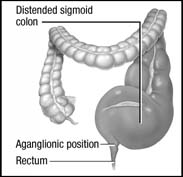Hirschsprung’s disease
Description
Absence of parasympathetic ganglionic cells in a segment of the colon (usually at the distal end of the large intestine)
Lack of nerve innervation leading to lack of, or alteration in, peristalsis in the affected part (see A look at Hirschsprung’s disease, page 106)
Pathophysiology
Stool enters the affected part and remains there until additional stool pushes it through.
The affected part of the colon dilates, possibly resulting in a mechanical obstruction.
Causes
Commonly coexisting with other congenital anomalies, particularly Down syndrome (trisomy 21) and anomalies of the urinary tract
Stay updated, free articles. Join our Telegram channel

Full access? Get Clinical Tree



